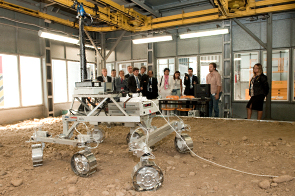ExoMars Rover Rosalind Franklin
The ExoMars Rover, developed by ESA, provides key mission capabilities: surface mobility, subsurface drilling and automatic sample collection, processing, and distribution to instruments. It hosts a suite of analytical instruments dedicated to exobiology and geochemistry research: this is the Pasteur payload.
 |
| The ExoMars Rover Prototype. Credit: Thales Alenia Space Italy |
The Rover, named Rosalind Franklin, uses solar panels to generate the required electrical power, and is designed to survive the cold Martian nights with the help of novel batteries and heater units.
Due to the infrequent communication opportunities, only one or two short sessions per sol (Martian day), Rosalind Franklin is highly autonomous. Scientists on Earth will designate target destinations on the basis of compressed stereo images acquired by the cameras mounted on the Rover mast.
Rosalind Franklin must then calculate navigation solutions and safely travel approximately 100 m per sol. To achieve this, it creates digital maps from navigation stereo cameras and computes a suitable trajectory. Close-up collision avoidance cameras are used to ensure safety.
The locomotion is achieved through six wheels. Each wheel pair is suspended on an independently pivoted bogie (the articulated assembly holding the wheel drives), and each wheel can be independently steered and driven. All wheels can be individually pivoted to adjust Rosalind Franklin's height and angle with respect to the local surface, and to create a sort of walking ability, particularly useful in soft, non-cohesive soils like dunes. In addition, inclinometers and gyroscopes are used to enhance the motion control robustness. Finally, Sun sensors are utilised to determine the rover’s absolute attitude on the Martian surface and the direction to Earth.
The camera system's images, combined with ground penetrating radar data collected while travelling, will allow scientists on-ground to define suitable drilling locations.
Rosalind Franklin's subsurface sampling device will then autonomously drill to the required depth (maximum 2 m) while investigating the borehole wall mineralogy, and collect a small sample. This sample will be delivered to the analytical laboratory in the heart of the vehicle. The laboratory hosts four different instruments and several support mechanisms. The sample will be crushed into a fine powder. By means of a dosing station the powder will then be presented to other instruments for performing a detailed chemistry, physical, and spectral analyses.
